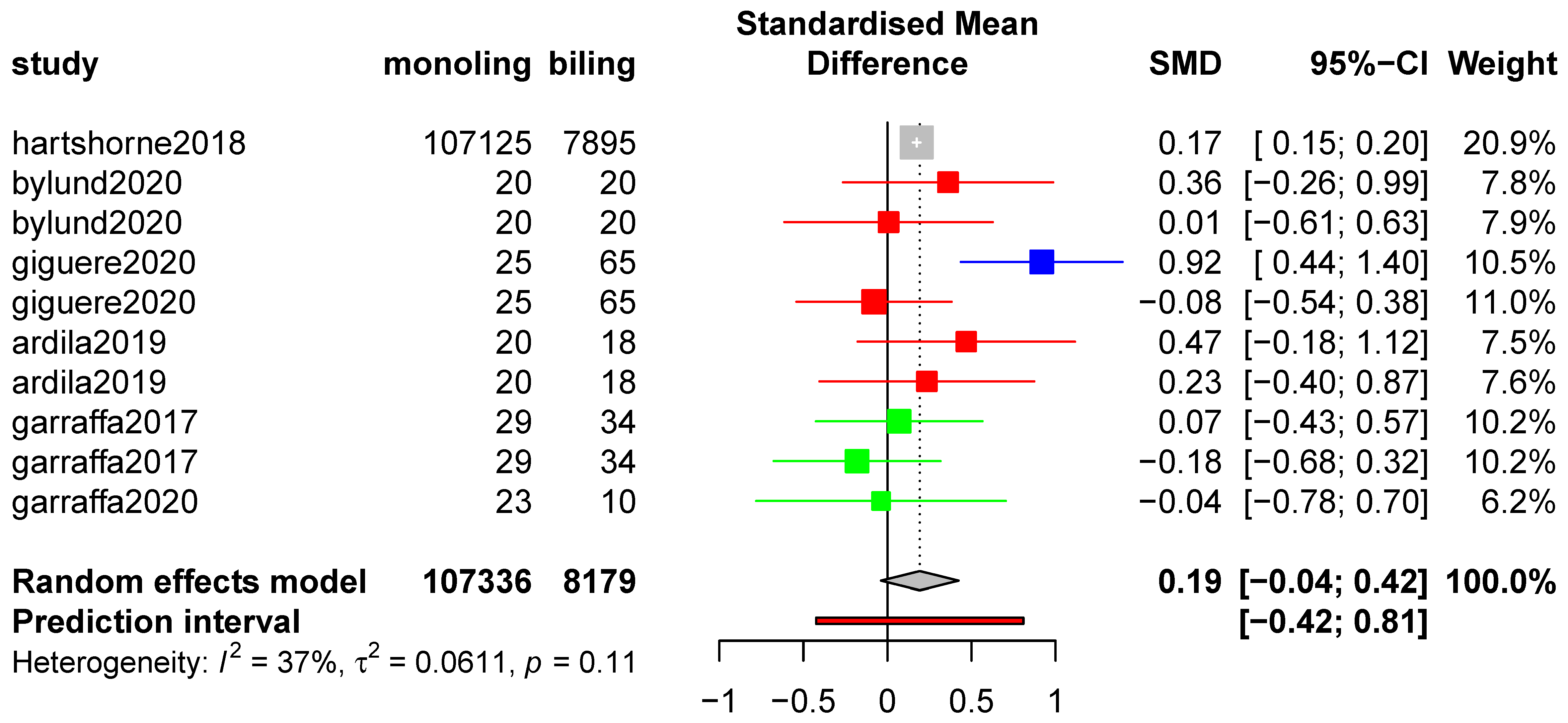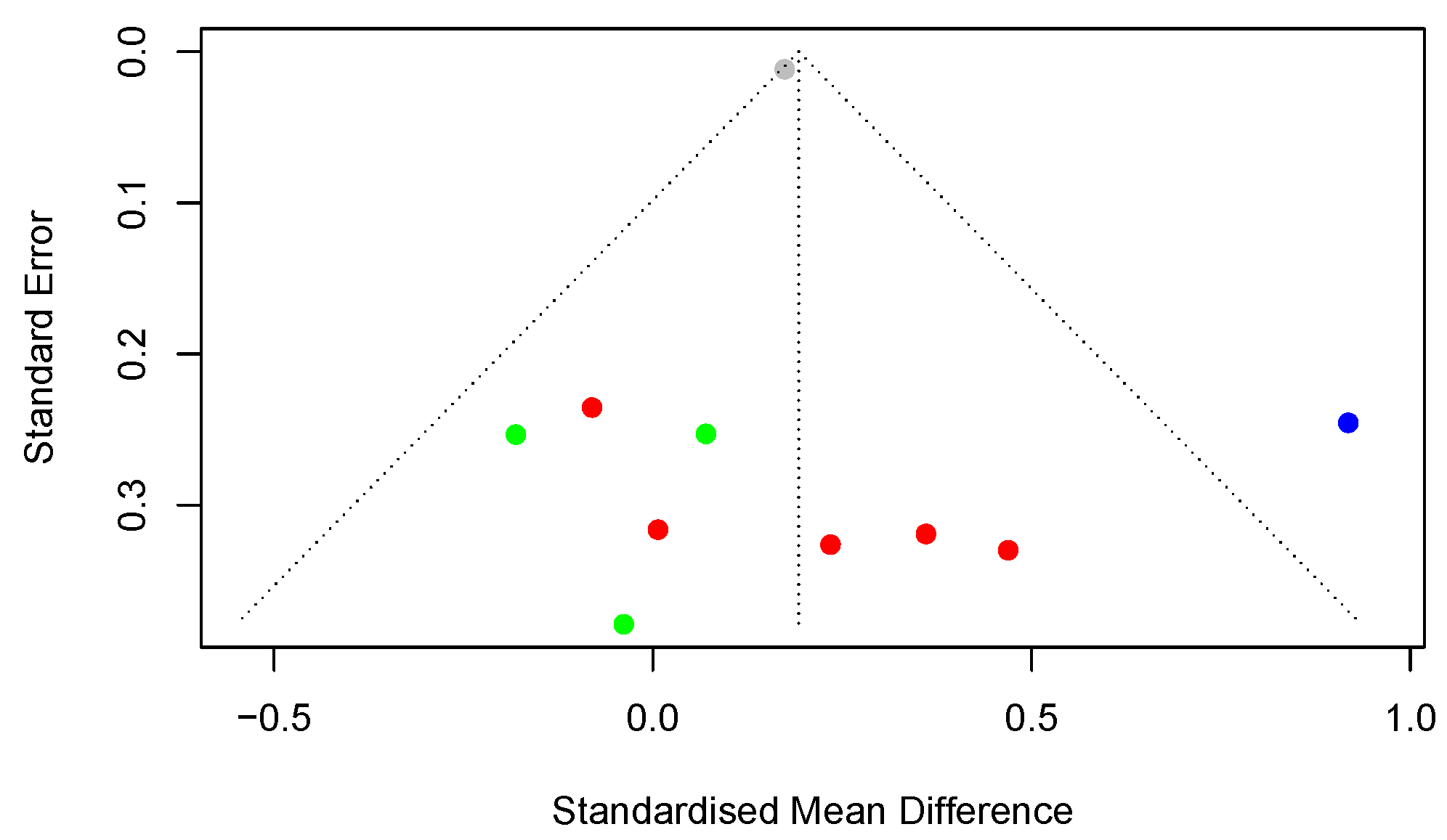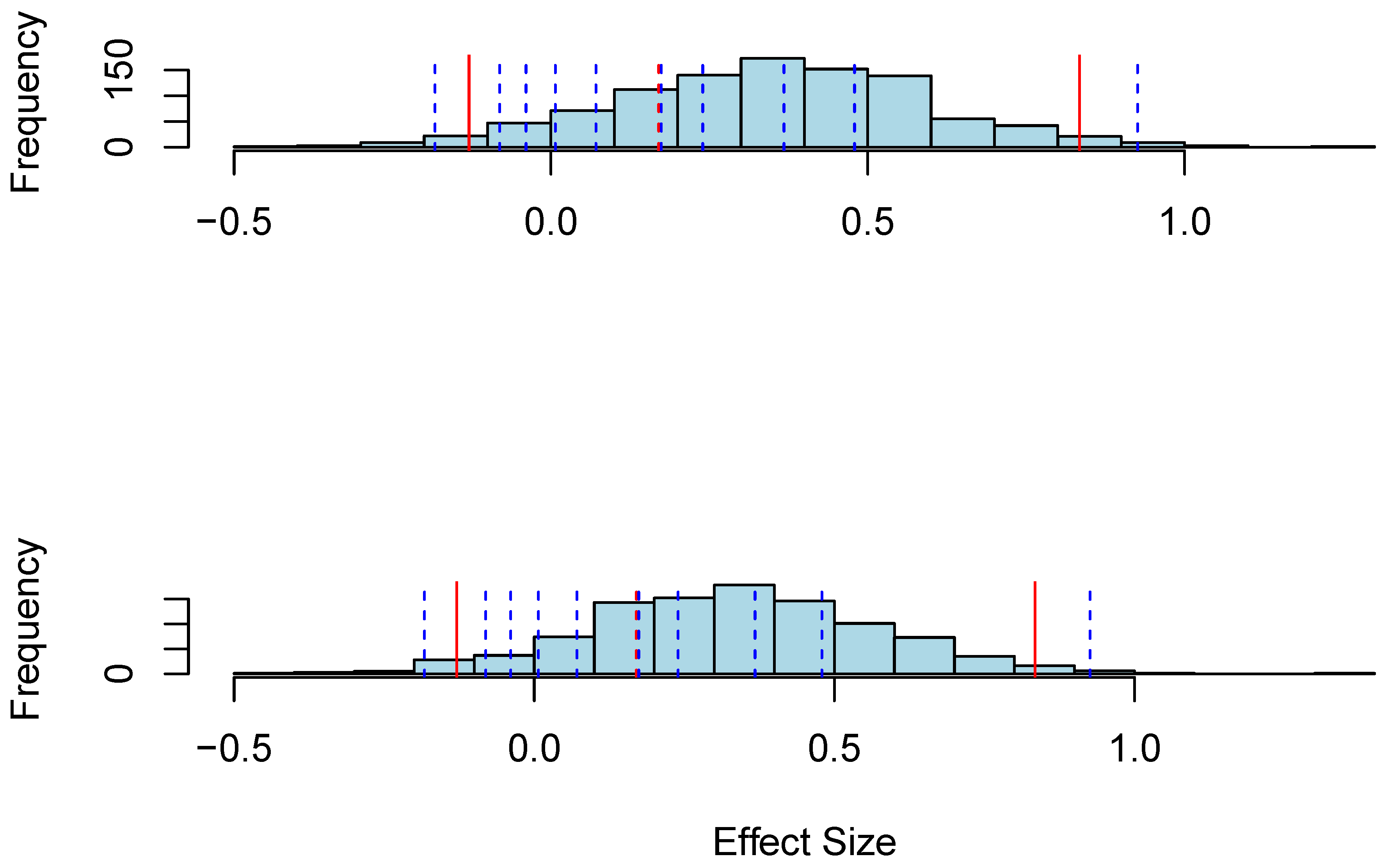Even Simultaneous Bilinguals Do Not Reach Monolingual Levels of Proficiency in Syntax
Abstract
1. Introduction
1.1. Two Monolinguals in One Brain Hypothesis: State of the (Syntactic) Evidence
1.2. Overview of the Present Paper
2. Study 1: Meta-Analysis
2.1. Target Papers
2.2. Data Entry
2.3. Results
2.4. Discussion
3. Study 2: Monte Carlo Simulations
3.1. Bootstrapping from the Data of Hartshorne and Colleagues
3.2. Method
3.3. Results and Discussion
4. Study 3: Comparing Simultaneous Bilinguals Whose Primary Language Is or Is Not English
4.1. Method
4.2. Results and Discussion
5. General Discussion
5.1. Interpreting Effect Size
5.2. Explaining High (But Below-Ceiling) Performance by Simultaneous Bilinguals
6. Limitations and Conclusions
Author Contributions
Funding
Institutional Review Board Statement
Informed Consent Statement
Data Availability Statement
Acknowledgments
Conflicts of Interest
| 1 | . |
| 2 | The estimated effect is 0.20 with 95% confidence interval [−0.08, 0.48] using a random effects model, after excluding Hartshorne et al. (2018). The heterogeneity is larger but still insignificant ( = 0.44, p = 0.08). |
| 3 | Technically, some of these are simultaneous multilinguals. As noted previously, we use the term ‘bilingual’ in the more general sense of more than one language. |
| 4 | One might expect, given their more variable circumstances, simultaneous bilinguals might show more variability in performance than do monolinguals. We compared the variability (as measured by coefficient of variation) for monolinguals and simultaneous bilinguals for ages 12 through 67 in year-sized bins (i.e., 7 yo, 8 yo, 9 yo, … 75 yo), restricted to those who listed English as their primary language. This age range was chosen to ensure at least 20 subjects per bin; less than that, and measurement of coefficient of variation is very unstable. While accuracy was significantly higher for monolinguals relative to simultaneous bilinguals at nearly every age (see HTP), variation was generally similar at each age and did not differ as a group (t(55) = 1.73, p = 0.09). Similar results were obtained when measuring subject performance using expected ability inferred from a 4PL IRT model (cf. Hartshorne and Chen (2021)) instead of using elogit-transformed accuracy (as done here and in HTP). However, we should note that estimating variability is difficult when performance is close to ceiling, which is the case for both monolinguals and simultaneous bilinguals. |
| 5 | These estimates do not necessarily exclude non-significant results. However, since the vast majority of reported results are significant, this is unlikely to bias estimates much (Fanelli 2010; Sterling et al. 1995). |
References
- Ardila, Alfredo, Mónica Rosselli, Alexandra Ortega, Merike Lang, and Valeria L. Torres. 2019. Oral and written language abilities in young spanish/english bilinguals. International Journal of Bilingualism 23: 296–312. [Google Scholar] [CrossRef]
- Bakker, Marjan, Annette Van Dijk, and Jelte M. Wicherts. 2012. The rules of the game called psychological science. Perspectives on Psychological Science 7: 543–54. [Google Scholar] [CrossRef] [PubMed]
- Balduzzi, Sara, Gerta Rücker, and Guido Schwarzer. 2019. How to perform a meta-analysis with R: A practical tutorial. Evidence-Based Mental Health 22: 153–60. [Google Scholar] [CrossRef] [PubMed]
- Birdsong, David. 2005. Nativelikeness and non-nativelikeness in L2A research1. IRAL, International Review of Applied Linguistics in Language Teaching 43: 319. [Google Scholar] [CrossRef]
- Birdsong, David, and Libby M. Gertken. 2013. In faint praise of folly: A critical review of native/non-native speaker comparisons, with examples from native and bilingual processing of french complex syntax. Language, Interaction and Acquisition 4: 107–33. [Google Scholar] [CrossRef]
- Bylund, Emanuel, Kenneth Hyltenstam, and Niclas Abrahamsson. 2020. Age of acquisition—not bilingualism—is the primary determinant of less than nativelike L2 ultimate attainment. Bilingualism: Language and Cognition 24: 18–30. [Google Scholar] [CrossRef]
- Campbell, Mhairi, Joanne E. McKenzie, Amanda Sowden, Srinivasa Vittal Katikireddi, Sue E. Brennan, Simon Ellis, Jamie Hartmann-Boyce, Rebecca Ryan, Sasha Shepperd, James Thomas, and et al. 2020. Synthesis without meta-analysis (SWiM) in systematic reviews: Reporting guideline. BMJ 368: l6890. [Google Scholar] [CrossRef]
- Cohen, Jacob. 1988. Statistical Power Analysis for the Behavioral Sciences. Hillsdale: Lawrence Erlbaum Associates, pp. 18–74. [Google Scholar]
- Crain, Stephen. 1991. Language acquisition in the absence of experience. Behavioral and Brain Sciences 14: 597–612. [Google Scholar] [CrossRef]
- Fanelli, Daniele. 2010. “Positive” results increase down the hierarchy of the sciences. PLoS ONE 5: e10068. [Google Scholar] [CrossRef]
- Fleiss, J. 1993. Review papers: The statistical basis of meta-analysis. Statistical Methods in Medical Research 2: 121–45. [Google Scholar] [CrossRef]
- Garraffa, Maria, Mateo Obregon, and Antonella Sorace. 2017. Linguistic and cognitive effects of bilingualism with regional minority languages: A study of sardinian–italian adult speakers. Frontiers in Psychology 8: 1907. [Google Scholar] [CrossRef]
- Garraffa, Maria, Mateo Obregon, Bernadette O’Rourke, and Antonella Sorace. 2020. Language and cognition in gaelic-english young adult bilingual speakers: A positive effect of school immersion program on attentional and grammatical skills. Frontiers in Psychology 11: 2758. [Google Scholar] [CrossRef] [PubMed]
- Gignac, Gilles E., and Eva T. Szodorai. 2016. Effect size guidelines for individual differences researchers. Personality and Individual Differences 102: 74–78. [Google Scholar] [CrossRef]
- Giguere, David, and Erika Hoff. 2020. Home language and societal language skills in second-generation bilingual adults. International Journal of Bilingualism 24: 1071–87. [Google Scholar] [CrossRef]
- Grosjean, François. 1989. Neurolinguists, beware! The bilingual is not two monolinguals in one person. Brain and Language 36: 3–15. [Google Scholar] [CrossRef]
- Grosjean, François. 2016. The complementarity principle and its impact on processing, acquisition, and dominance. In Language Dominance in Bilinguals. Edited by Jeanine Treffers-Daller and Carmen Silva-Corvalán. Cambridge: Cambridge University Press, pp. 66–84. [Google Scholar] [CrossRef]
- Hartshorne, Joshua K., and Adena Schachner. 2012. Tracking replicability as a method of post-publication open evaluation. Frontiers in Computational Neuroscience 6: 8. [Google Scholar] [CrossRef]
- Hartshorne, Joshua K., and Laura T. Germine. 2015. When does cognitive functioning peak? The asynchronous rise and fall of different cognitive abilities across the life span. Psychological Science 26: 433–43. [Google Scholar] [CrossRef]
- Hartshorne, Joshua K., and Tony Chen. 2021. More evidence from over 1.1 million subjects that the critical period for syntax closes in late adolescence. Cognition 214: 104706. [Google Scholar]
- Hartshorne, Joshua K., Joshua B. Tenenbaum, and Steven Pinker. 2018. A critical period for second language acquisition: Evidence from 2/3 million English speakers. Cognition 177: 263–77. [Google Scholar] [CrossRef]
- Hemphill, James F. 2003. Interpreting the magnitudes of correlation coefficients. The American Psychologist 58: 78–79. [Google Scholar] [CrossRef]
- Hurford, James R. 1991. The evolution of the critical period for language acquisition. Cognition 40: 159–201. [Google Scholar] [CrossRef]
- Jaeger, T. Florian. 2008. Categorical data analysis: Away from ANOVAs (transformation or not) and towards logit mixed models. Journal of Memory and Language 59: 434–46. [Google Scholar] [CrossRef] [PubMed]
- Klein, Richard A., Michelangelo Vianello, Fred Hasselman, Byron G. Adams, Reginald B. Adams, Jr., Sinan Alper, Mark Aveyard, Jordan R. Axt, Mayowa T. Babalola, Štěpán Bahník, and et al. 2019. Many labs 2: Investigating variation in replicability across sample and setting. Advances in Methods and Practices in Psychological Science 1: 443–90. [Google Scholar] [CrossRef]
- Lakshmanan, Usha. 2013. Bilingual Assessment. Hoboken: John Wiley & Sons, Inc. [Google Scholar] [CrossRef]
- Langsford, Steven, Amy Perfors, Andrew T. Hendrickson, Lauren A. Kennedy, and Danielle J. Navarro. 2018. Quantifying sentence acceptability measures: Reliability, bias, and variability. Glossa: A Journal of General Linguistics 3: 37. [Google Scholar] [CrossRef]
- Open Science Collaboration. 2015. Estimating the reproducibility of psychological science. Science 349. [Google Scholar] [CrossRef]
- Page, Matthew J., Joanne E. McKenzie, Patrick M. Bossuyt, Isabelle Boutron, Tammy C. Hoffmann, Cynthia D. Mulrow, Larissa Shamseer, Jennifer M. Tetzlaff, Elie A. Akl, Sue E. Brennan, and et al. 2021. The PRISMA 2020 statement: An updated guideline for reporting systematic reviews. International Journal of Surgery 88: 105906. [Google Scholar] [CrossRef] [PubMed]
- Pinker, Steven. 1994. The Language Instinct. New York: William Morrow and Company. [Google Scholar]
- Plonsky, Luke, Ekaterina Sudina, and Yuhang Hu. 2021. Applying meta-analysis to research on bilingualism: An introduction. Bilingualism: Language and Cognition 24: 819–24. [Google Scholar] [CrossRef]
- Richard, F. Dan, Charles F. Bond, Jr., and Juli J. Stokes-Zoota. 2003. One hundred years of social psychology quantitatively described. Review of General Psychology 7: 331–63. [Google Scholar] [CrossRef]
- Schäfer, Thomas, and Marcus A. Schwarz. 2019. The meaningfulness of effect sizes in psychological research: Differences between sub-disciplines and the impact of potential biases. Frontiers in Psychology 10: 813. [Google Scholar] [CrossRef]
- Serratrice, Ludovica. 2013. Cross-linguistic influence in bilingual development: Determinants and mechanisms. Linguistic Approaches to Bilingualism 3: 3–25. [Google Scholar] [CrossRef]
- Snedeker, Jesse, Joy Geren, and Carissa L. Shafto. 2012. Disentangling the effects of cognitive development and linguistic expertise: A longitudinal study of the acquisition of english in internationally-adopted children. Cognitive Psychology 65: 39–76. [Google Scholar] [CrossRef]
- Stanley, Tom D., Evan C. Carter, and Hristos Doucouliagos. 2018. What meta-analyses reveal about the replicability of psychological research. Psychological Bulletin 144: 1325. [Google Scholar] [CrossRef] [PubMed]
- Sterling, Theodore D., Wilf L. Rosenbaum, and James J. Weinkam. 1995. Publication decisions revisited: The effect of the outcome of statistical tests on the decision to publish and vice versa. The American Statistician 49: 108–12. [Google Scholar]
- Street, James A., and Ewa Dąbrowska. 2010. More individual differences in language attainment: How much do adult native speakers of english know about passives and quantifiers? Lingua 120: 2080–94. [Google Scholar] [CrossRef]
- Thordardottir, Elin, Alyssa Rothenberg, Marie-Eve Rivard, and Rebecca Naves. 2006. Bilingual assessment: Can overall proficiency be estimated from separate measurement of two languages? Journal of Multilingual Communication Disorders 4: 1–21. [Google Scholar] [CrossRef]
- Wexler, Ken. 1998. Very early parameter setting and the unique checking constraint: A new explanation of the optional infinitive stage. Lingua 106: 23–79. [Google Scholar] [CrossRef]
- Zipf, George Kingsley. 1935. The Psycho-Biology of Language. Cambridge: The MIT Press. [Google Scholar]




Publisher’s Note: MDPI stays neutral with regard to jurisdictional claims in published maps and institutional affiliations. |
© 2022 by the authors. Licensee MDPI, Basel, Switzerland. This article is an open access article distributed under the terms and conditions of the Creative Commons Attribution (CC BY) license (https://creativecommons.org/licenses/by/4.0/).
Share and Cite
Li, W.; Hartshorne, J.K. Even Simultaneous Bilinguals Do Not Reach Monolingual Levels of Proficiency in Syntax. Languages 2022, 7, 293. https://doi.org/10.3390/languages7040293
Li W, Hartshorne JK. Even Simultaneous Bilinguals Do Not Reach Monolingual Levels of Proficiency in Syntax. Languages. 2022; 7(4):293. https://doi.org/10.3390/languages7040293
Chicago/Turabian StyleLi, Wei, and Joshua K. Hartshorne. 2022. "Even Simultaneous Bilinguals Do Not Reach Monolingual Levels of Proficiency in Syntax" Languages 7, no. 4: 293. https://doi.org/10.3390/languages7040293
APA StyleLi, W., & Hartshorne, J. K. (2022). Even Simultaneous Bilinguals Do Not Reach Monolingual Levels of Proficiency in Syntax. Languages, 7(4), 293. https://doi.org/10.3390/languages7040293







